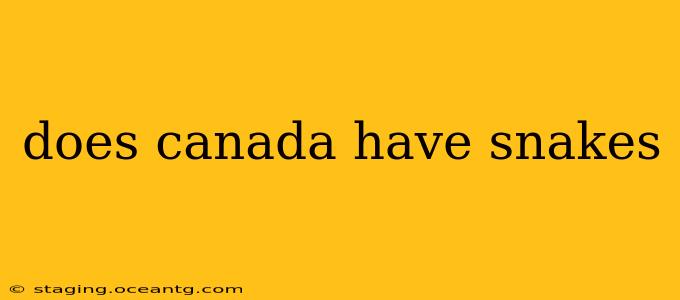Canada, with its vast and varied landscapes, is home to a surprising number of snake species, despite the country's colder climate. While the image of a snowy landscape might not immediately conjure up thoughts of slithering reptiles, the truth is that several snake species have adapted to survive in Canada's diverse habitats. This guide will explore the types of snakes found in Canada, their habitats, and address some frequently asked questions about these fascinating creatures.
What Kinds of Snakes Live in Canada?
Canada boasts a relatively modest number of snake species compared to warmer regions. However, these species display remarkable adaptations to survive in the challenging Canadian climate. The most common families found include the colubrids (harmless snakes) and, in a few regions, the viperids (venomous snakes). Here are a few examples:
-
Eastern Garter Snake (Thamnophis sirtalis): This is perhaps the most common snake in Canada, found across much of the country. They are highly adaptable and can be found near water sources, in meadows, and even in urban areas. They are non-venomous and primarily feed on amphibians and small fish.
-
Northern Red-bellied Snake (Storeria occipitomaculata): This small, slender snake is also non-venomous and typically found in moist environments such as forests and wetlands. Their striking red belly is a key identifying feature.
-
Eastern Hog-nosed Snake (Heterodon platirhinos): Known for its distinctive upturned snout and impressive defensive displays (including playing dead!), this snake is non-venomous but can secrete a foul-smelling musk. They are found in more southern regions of Canada.
-
Massasauga Rattlesnake (Sistrurus catenatus): This is the only venomous snake found in Canada. Its range is limited to specific regions, primarily in the southern parts of Ontario and Manitoba. It's critically endangered and requires protection.
Are Canadian Snakes Dangerous?
While Canada does have a venomous snake (the Massasauga rattlesnake), encounters are rare. The majority of snakes found in Canada are non-venomous and pose no threat to humans. They are more likely to flee at the sight of a human than to attack. However, it's always advisable to observe snakes from a safe distance and avoid handling them, even non-venomous species.
What Should I Do If I See a Snake in Canada?
If you encounter a snake in Canada, the best course of action is to observe it from a safe distance and leave it alone. Do not attempt to handle it, even if it appears harmless. Give it space to move away naturally. If you're concerned about a venomous snake (Massasauga rattlesnake), contact your local wildlife authorities for assistance.
Where in Canada Are Snakes Most Common?
Snakes are more commonly found in the warmer, southern regions of Canada. Provinces like Ontario, Quebec, and parts of the Maritimes have higher snake populations than the northern territories. Proximity to water sources, wetlands, and forests typically indicates a higher likelihood of encountering snakes.
What Do Canadian Snakes Eat?
The diet of Canadian snakes varies depending on the species. However, many feed on small rodents, amphibians (frogs, toads), fish, and insects. The Eastern Garter Snake, for instance, is known for its diet of amphibians and fish, while the Eastern Hog-nosed Snake favors toads and frogs.
Are All Snakes in Canada the Same?
No, Canadian snakes are quite diverse, differing significantly in appearance, habitat, and behavior. Even within the same species, variations in color and pattern can occur. Careful observation and identification guides are essential for distinguishing between species.
Conclusion
While not as diverse as in warmer climates, the snakes of Canada are a fascinating part of the country's biodiversity. Understanding their habitats, behavior, and the importance of co-existing peacefully contributes to their conservation and the preservation of Canada's rich natural heritage. Remember to observe from a distance and respect their space.
